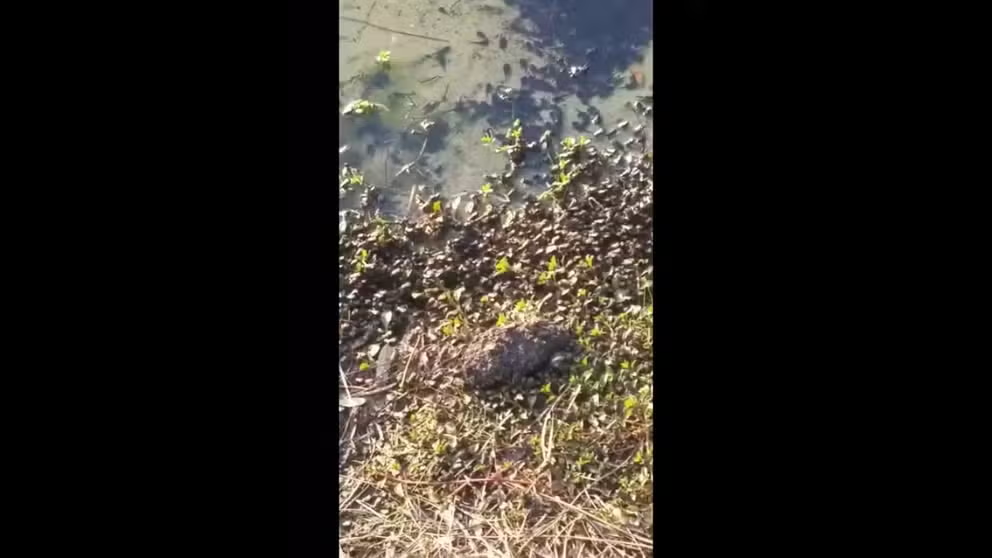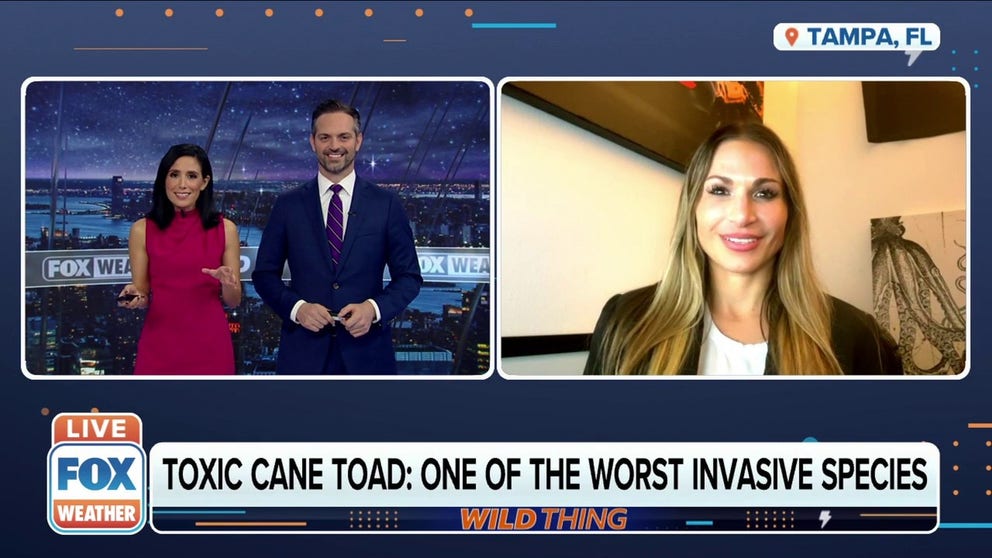Toxic cane toads successfully invaded and are killing pets and wildlife across Florida and Hawaii
The exotic toad, brought to the US to control pests, have successfully invaded our ecosystems. Governments and individuals search for ways to control the toad.
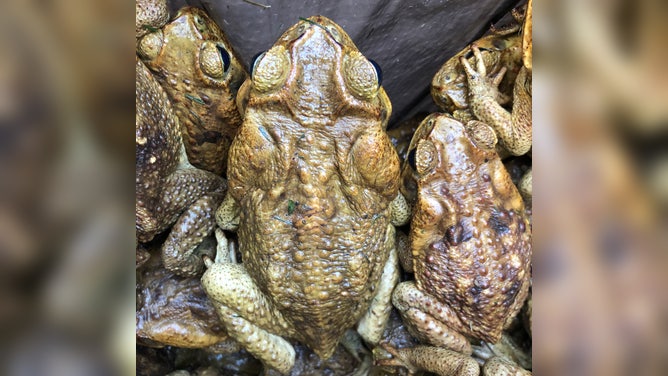
Cane toads
Toxic cane toads, brought to the U.S. to protect the sugar cane crop, quickly adapted and colonized Florida and Hawaii with few predators.
"I've been around many lakes in many different places," said a member of a large homeowners association in Southwest Florida. He agreed to speak to FOX Weather on the condition of anonymity. "I have never seen anything like this."
The member said he wanted to remain anonymous because he fears the effect the toads might have on property values in his neighborhood.
Cane toad, toadlets and tadpoles
Cane toad, toadlets and tadpoles in a Southwest Florida community's pond.
Look at the video he took of a freshwater pond, the bank literally moving.
PHOTO CAPTURES MOMENT 'NINJA PRAIRIE DOG' LUNGED AT BALD EAGLE
"That would have been in March of 2019," he said. "There were large masses of tadpoles and some of them had morphed into toadlets. There were hundreds of thousands of them."
According to a scientific paper published by the U.S. Forest Service and the U.S. Department of Agriculture, the toad is considered to be one of the 100 worst invasive species in the world.
When threatened, the nocturnal toads secrete bufotoxin, a poisonous venom, which can kill a dog in as little as 15 minutes, according to the Florida Fish and Wildlife Conservation Commission. The toads have large parotid glands behind both eyes and smaller ones across their body.
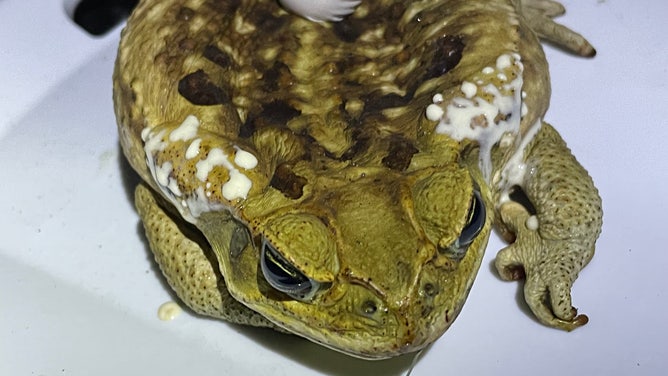
Cane toad secreting bufotoxin which can kill pets and wildlife in as little as 15 minutes.
Nextdoor.com in Southwest Florida had post after post about dogs and cats being poisoned or killed. Pet owners described excessive drooling, crying, convulsions and loss of coordination after their pet licked or bit the toad.
Steven Johnson, an associate professor in the Department of Wildlife Ecology and Conservation at the University of Florida, has published numerous articles and videos about the toads.
He demonstrated how pet owners could immediately address the situation if they believed their pet had come into contact with one of the toads in a video posted here.
"You have to act fast," Johnson said in the video. "First, take a wet rag and wipe out your pet’s mouth. Be sure to wipe the tongue gums and inside and outside of your pet’s lips. Cane toad poison is very thick and sticky, and you want to be thorough with the rag. Next, use a garden hose with a steady but not too strong flow to thoroughly rinse your pet’s mouth out for about 10 minutes. And be sure to point the mouth of your pet in a downward direction, so the water runs out of the mouth and not down the throat. Afterwards, call your local veterinarian for additional advice."
The toxin irritates human skin and burns the eyes. The HOA member said it left a rash on his skin for a couple of days.
Why are they in the US?
Plantation owners brought the toads to Florida, Hawaii, Puerto Rico and Australia in the 1930s to rid sugar cane fields of beetles. Thus, they earned the name "cane" toads. According to a paper published by Johnson, the initial group from the 30s died out in Florida.
"In the 1950s, a pet importer released about 100 cane toads – maybe on accident or on purpose, no one is sure – at the Miami airport," Johnson wrote. That brood took hold.
The "Bufo" toad is native to South and Central America and a few counties in south Texas. Given its Texas roots, you may not be surprised to learn that this is the largest toad in North America growing on average between 6-9 inches long. The Guinness Book of World Records weighed in a pet cane toad in Sweden at 1 foot, 3 inches and 5 pounds, 13 ounces.
Native toads are generally only 3-4 inches, Johnson said in his publication on the cane toad.
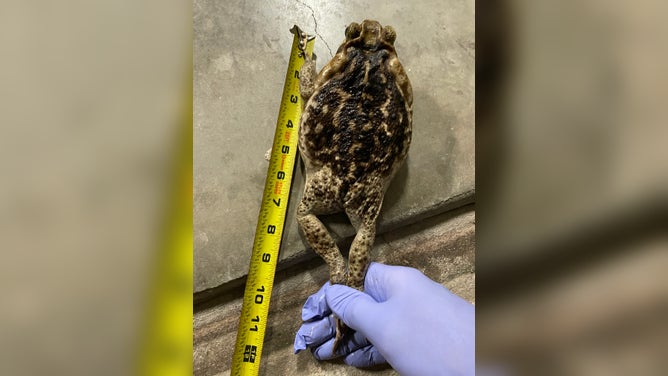
Cane toads are easily identified by their size as they are much larger than native toads.
Dangerous to wildlife
Cane toads are toxic at all stages of life and death. Eggs, tadpoles, toadlets, toads and roadkill are all poisonous if ingested – killing birds, reptiles, snakes and fish that eat them.
A 2008 research paper out of the University of Sidney detailed a "massive mortality" of freshwater crocodiles when the cane toads arrived decreasing the population by 77%.
Where to look for cane toads
Cane toads settle in human-modified habitats like yards and golf courses, not in natural areas like dense vegetation. So, it is inevitable that humans and cane toads cross paths.
Johnson wrote that they adapt quickly to new conditions and can survive in a wide range of weather conditions, so they colonized golf courses, yards, gardens and farms.
The HOA member in Southwest Florida researched the toad and organized a community effort with the Florida Fish and Wildlife Conservation Commission to control the cane toads.
He surveyed several golf courses.
"They're in the middle of the damn golf course," the HOA member said.
He said he found thousands one night after dark.
"Cane toads, when it's getting light, go into the yards under vegetation anywhere it's dark, and they hang out until it's dark again," the HOA member said. "We water them for free. The bugs come around for free. It's easy to get around."
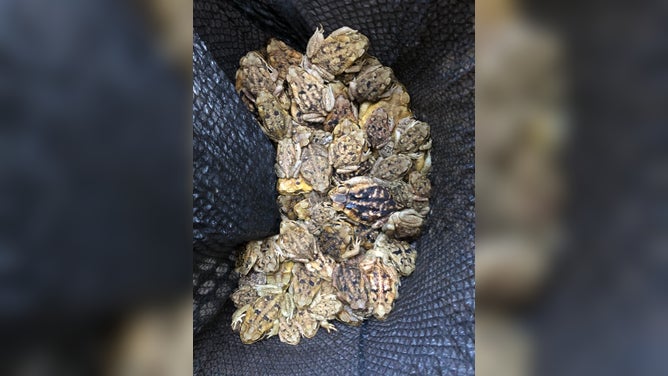
Wildlife trappers and volunteers collect cane toads from yards and golf courses.
Cane toads eat vegetation, native toads, frogs, insects, small birds, lizards, small mammals, snakes, pet food, even human table scraps from the garbage, picnic tables and grills.
The toads breed year-round in South Florida usually after heavy rains. In cooler, drier regions, the toads breed March to September.
It's easy to see how, with very few natural predators, the cane toads proliferate. In one night, females can lay strings of 8,000–30,000 eggs up to twice a year in shallow water such as ponds, canals and koi ponds. Tadpoles hatch in about two days. Depending on the temperature, they mature in two weeks to two months. Adults live on average 10-15 years.
Communities take action
The Southwest Florida community took action. They hired wildlife trappers and organized volunteers. According to the HOA member, they caught about 20,000 adult toads in the first year.
Volunteers also scooped tadpoles and toadlets from ponds. The HOA member said a fellow volunteer and naturalist estimated the group removed 8.5 million tadpoles just last year.
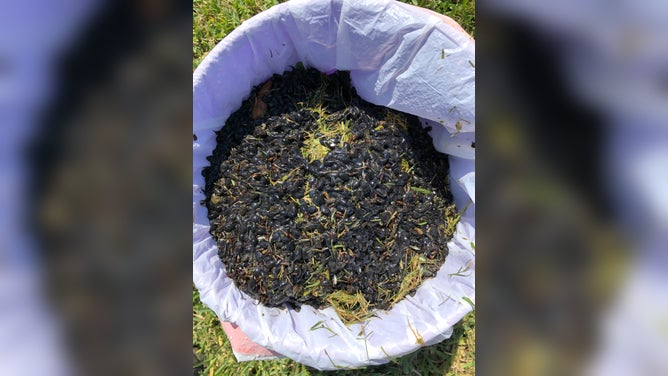
Volunteers scoop bucket after bucket of tadpoles and toadlets from their community's ponds.
Florida law prohibits trapping and relocating non-native species, so the question is what do you do with those 20,000 cane toads?
"First, you put it into a refrigerator," the HOA member said, citing research about how to euthanize the toads. "The reason you do that, it slows the body down and then you take it after 24 hours. Then you put it into a freezer for at least 48 hours, it'll be frozen solid. You can just toss it in the trash."
According to the HOA member, there has been a 50% to 65% reduction in the number of adult cane toads in the past two years since the start of their control program.
Toxic Cane Toads are Invading the United States
Environmental Engineer Tracy Fanara joins FOX Weather to explain the dangers of cane toads and how to protect you and your pets from them.
Editors Note: An earlier version of this story incorrectly stated Dr. Johnson is a veterinarian. He is an associate professor and tenured member of the Dept. of Wildlife Ecology and Conservation at the University of Florida. This story has been edited to include a broader look at Dr. Johnson’s research into the cane toads, specifically highlighting his contributions to his field of study published in the state of Florida.
